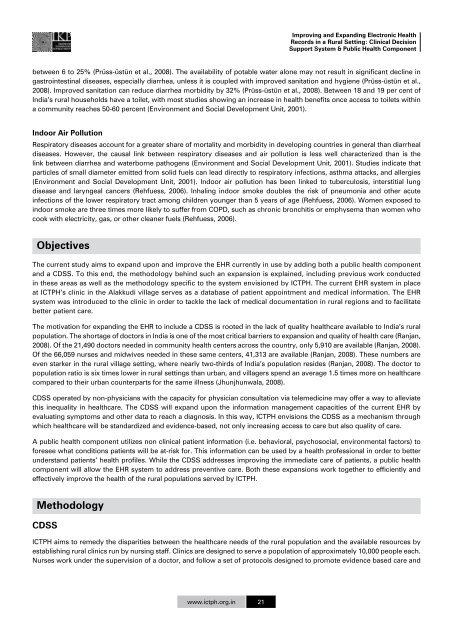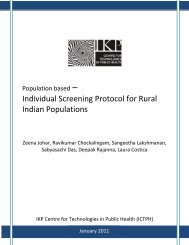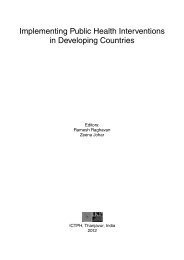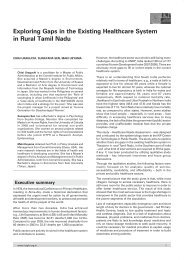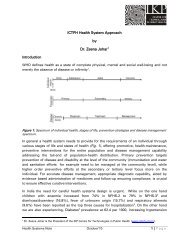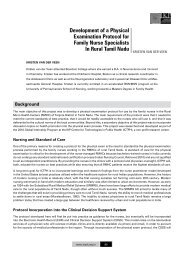Improving and Expanding Electronic Health Records in a Rural Setting
Improving and Expanding Electronic Health Records in a Rural Setting
Improving and Expanding Electronic Health Records in a Rural Setting
You also want an ePaper? Increase the reach of your titles
YUMPU automatically turns print PDFs into web optimized ePapers that Google loves.
<strong>Improv<strong>in</strong>g</strong> <strong>and</strong> Exp<strong>and</strong><strong>in</strong>g <strong>Electronic</strong> <strong>Health</strong><br />
<strong>Records</strong> <strong>in</strong> a <strong>Rural</strong> Sett<strong>in</strong>g: Cl<strong>in</strong>ical Decision<br />
Support System & Public <strong>Health</strong> Component<br />
between 6 to 25% (Prüss-üstün et al., 2008). The availability of potable water alone may not result <strong>in</strong> significant decl<strong>in</strong>e <strong>in</strong><br />
gastro<strong>in</strong>test<strong>in</strong>al diseases, especially diarrhea, unless it is coupled with improved sanitation <strong>and</strong> hygiene (Prüss-üstün et al.,<br />
2008). Improved sanitation can reduce diarrhea morbidity by 32% (Prüss-üstün et al., 2008). Between 18 <strong>and</strong> 19 per cent of<br />
India’s rural households have a toilet, with most studies show<strong>in</strong>g an <strong>in</strong>crease <strong>in</strong> health benefits once access to toilets with<strong>in</strong><br />
a community reaches 50-60 percent (Environment <strong>and</strong> Social Development Unit, 2001).<br />
Indoor Air Pollution<br />
Respiratory diseases account for a greater share of mortality <strong>and</strong> morbidity <strong>in</strong> develop<strong>in</strong>g countries <strong>in</strong> general than diarrheal<br />
diseases. However, the causal l<strong>in</strong>k between respiratory diseases <strong>and</strong> air pollution is less well characterized than is the<br />
l<strong>in</strong>k between diarrhea <strong>and</strong> waterborne pathogens (Environment <strong>and</strong> Social Development Unit, 2001). Studies <strong>in</strong>dicate that<br />
particles of small diameter emitted from solid fuels can lead directly to respiratory <strong>in</strong>fections, asthma attacks, <strong>and</strong> allergies<br />
(Environment <strong>and</strong> Social Development Unit, 2001). Indoor air pollution has been l<strong>in</strong>ked to tuberculosis, <strong>in</strong>terstitial lung<br />
disease <strong>and</strong> laryngeal cancers (Rehfuess, 2006). Inhal<strong>in</strong>g <strong>in</strong>door smoke doubles the risk of pneumonia <strong>and</strong> other acute<br />
<strong>in</strong>fections of the lower respiratory tract among children younger than 5 years of age (Rehfuess, 2006). Women exposed to<br />
<strong>in</strong>door smoke are three times more likely to suffer from COPD, such as chronic bronchitis or emphysema than women who<br />
cook with electricity, gas, or other cleaner fuels (Rehfuess, 2006).<br />
Objectives<br />
The current study aims to exp<strong>and</strong> upon <strong>and</strong> improve the EHR currently <strong>in</strong> use by add<strong>in</strong>g both a public health component<br />
<strong>and</strong> a CDSS. To this end, the methodology beh<strong>in</strong>d such an expansion is expla<strong>in</strong>ed, <strong>in</strong>clud<strong>in</strong>g previous work conducted<br />
<strong>in</strong> these areas as well as the methodology specific to the system envisioned by ICTPH. The current EHR system <strong>in</strong> place<br />
at ICTPH’s cl<strong>in</strong>ic <strong>in</strong> the Alakkudi village serves as a database of patient appo<strong>in</strong>tment <strong>and</strong> medical <strong>in</strong>formation. The EHR<br />
system was <strong>in</strong>troduced to the cl<strong>in</strong>ic <strong>in</strong> order to tackle the lack of medical documentation <strong>in</strong> rural regions <strong>and</strong> to facilitate<br />
better patient care.<br />
The motivation for exp<strong>and</strong><strong>in</strong>g the EHR to <strong>in</strong>clude a CDSS is rooted <strong>in</strong> the lack of quality healthcare available to India’s rural<br />
population. The shortage of doctors <strong>in</strong> India is one of the most critical barriers to expansion <strong>and</strong> quality of health care (Ranjan,<br />
2008). Of the 21,490 doctors needed <strong>in</strong> community health centers across the country, only 5,910 are available (Ranjan, 2008).<br />
Of the 66,059 nurses <strong>and</strong> midwives needed <strong>in</strong> these same centers, 41,313 are available (Ranjan, 2008). These numbers are<br />
even starker <strong>in</strong> the rural village sett<strong>in</strong>g, where nearly two-thirds of India’s population resides (Ranjan, 2008). The doctor to<br />
population ratio is six times lower <strong>in</strong> rural sett<strong>in</strong>gs than urban, <strong>and</strong> villagers spend an average 1.5 times more on healthcare<br />
compared to their urban counterparts for the same illness (Jhunjhunwala, 2008).<br />
CDSS operated by non-physicians with the capacity for physician consultation via telemedic<strong>in</strong>e may offer a way to alleviate<br />
this <strong>in</strong>equality <strong>in</strong> healthcare. The CDSS will exp<strong>and</strong> upon the <strong>in</strong>formation management capacities of the current EHR by<br />
evaluat<strong>in</strong>g symptoms <strong>and</strong> other data to reach a diagnosis. In this way, ICTPH envisions the CDSS as a mechanism through<br />
which healthcare will be st<strong>and</strong>ardized <strong>and</strong> evidence-based, not only <strong>in</strong>creas<strong>in</strong>g access to care but also quality of care.<br />
A public health component utilizes non cl<strong>in</strong>ical patient <strong>in</strong>formation (i.e. behavioral, psychosocial, environmental factors) to<br />
foresee what conditions patients will be at-risk for. This <strong>in</strong>formation can be used by a health professional <strong>in</strong> order to better<br />
underst<strong>and</strong> patients’ health profiles. While the CDSS addresses improv<strong>in</strong>g the immediate care of patients, a public health<br />
component will allow the EHR system to address preventive care. Both these expansions work together to efficiently <strong>and</strong><br />
effectively improve the health of the rural populations served by ICTPH.<br />
Methodology<br />
CDSS<br />
ICTPH aims to remedy the disparities between the healthcare needs of the rural population <strong>and</strong> the available resources by<br />
establish<strong>in</strong>g rural cl<strong>in</strong>ics run by nurs<strong>in</strong>g staff. Cl<strong>in</strong>ics are designed to serve a population of approximately 10,000 people each.<br />
Nurses work under the supervision of a doctor, <strong>and</strong> follow a set of protocols designed to promote evidence based care <strong>and</strong><br />
www.ictph.org.<strong>in</strong> 21


